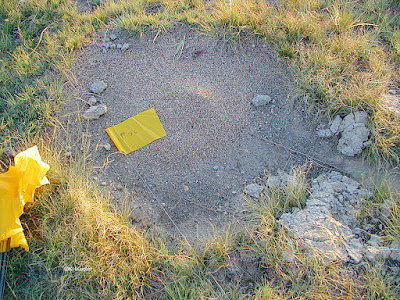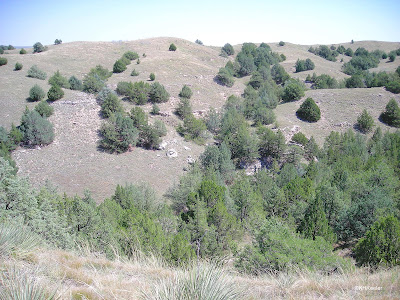I just published a research project I began in 1977.
I had no idea what I was getting into. E. O. Wilson wrote in The Insect Societies (1971) that we only knew how long the colonies of four ant species lived. I looked at the conspicuous mounds of the western harvester ant, Pogonomyrmex occidentalis, in western Nebraska and thought "I can find out how long those live, just follow them for some years." So I walked along the ridge above the University of Nebraska's Cedar Point Biological Station, Ogallala, Nebraska, and put down a number scraped into a square cut out of a steel pop can and held down by a nail in the center, by every harvester ant colony I saw. Then the next year, I came back to see how many of the colonies were still alive.
 |
| harvester ant nest in the shortgrass prairie (the pile of pebbles) |
How long ants live is complicated. Worker ants live weeks or months to maybe years. But some colonies have queens that live longer than that. Other colonies are potentially immortal, because they have multiple queens, either simultaneously or sequentially. For harvester ants, a group of ants of the dry lands from North America to South America, I was only guessing that they were single-queen colonies in 1977, but studies since then have all supported that a single queen founds a harvester ant colony and the colony lasts until she dies. My study thus followed the lives of 112 individual ant queens.
Each year about August 1, I recorded the colonies as alive or dead (and measured the live ones). Then I marked and measured any colonies I found in the study area that were not already marked.
 |
| Harvester ant nest. A mound of tiny stones is surrounded by an area cleared of plants. |
In 1982, I looked at the change over five years, and calculated that colonies would live 22-43 years. Really? Individual ants?
By 1994 I was tired of searching for ant colonies and also, 15 years of scientific progress let me see that to have done this right, I should have marked the colonies in three different but similar places. I thought when I set it up that 100 ant colonies was good replication, but all those colonies share the same environment, which limits the generality of the study. By 1994, my main research was on polyploidy in prairie grasses, not ant-plant interactions as it had been in 1977, so I scaled the study down, just following the already-marked colonies to verify my predictions of longevity.
I went back again...and again...and again. The last colony died in 2018. I was sad for it, but happy to be done.
 |
| The harvester ant populations were on the hilltops; I'm standing in my study site, looking east |
Ants are important animals. They are very abundant on every continent except Antarctica. A recent study estimated the number of ants in the world as 20 quadrillion (20x1015) and that in biomass (dry weight) they exceed the weight of all wild mammals and birds combined. Most ants are scavengers and predators, so, as scavengers, they have a huge impact cleaning up the environment and, as predators they remove a lot of small animals, mainly insects.
Harvester ants are unusual in being largely herbivorous. The workers gather seeds which, deep in the nest, they feed to the larvae. They feed the larvae dead bugs as well. Because the colonies can be large (to 8,000 for this species) and stay in the same place for years, their seed preferences have an important effect on which nearby plants reproduce successfully. Studies of their seed-gathering show they will take a very broad range of seeds, but of course they prefer some seeds over others (like, nice big flat yucca seeds, not the tiny, round ones that easily slip out from between one's mandibles). So, if I need to relate this post to plants, that is the link: animals that eat plants come in many forms, and one is the western harvester ant. Harvester ant colonies are big, persistent seed eaters.
Any time you get in the western U.S. (west from the western Dakotas south to west Texas), watch for harvester ants; the colonies are big and obvious. And, long-lived.
 |
| Harvester ant colony |
Comments and corrections welcome.
References
Keeler, K.H. 2022. Longitudinal study of Pogonomyrmex occidentalis (Hymenoptera: Formicideae), western harvester ant, colongy survival in western Nebraska. The Southwestern Naturalist. 66(2):114-119.
S Shultheiss, P., S.S. Nooten, R. Wang, M.K.L. Wong, F. Brassard and B. Guénard. 2022.The abundance, biomass, and distribution of ants on Earth. PNAS. 119 (40) e2201550119 link
Wilson, E.O. 1971. The Insect Societies. Belknap Press, Harvard.
Ant-Wiki has a good page on Pogonomyrmex occidentalis: link

Interesting! Pheidole megacephala is one of those species that can be considered potentially immortal, and a colony of this species has been in the Marie Selby Botanical Gardens (in FL) and its surrounding environs since 1989...more than 30 years.
ReplyDelete